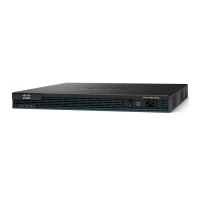
Do you have a question about the Cisco 2900 Series and is the answer not in the manual?
| Form Factor | Rack-mountable |
|---|---|
| Default DRAM | 512 MB |
| Default Flash | 256 MB |
| Connectivity Technology | Wired |
| Data Link Protocol | Ethernet, Fast Ethernet, Gigabit Ethernet |
| Operating System | Cisco IOS |
| Operating Temperature | 32 to 104°F (0 to 40°C) |
| Storage Temperature | -4 to 149°F (-20 to 65°C) |
| Models | 2911, 2921, 2951 |
| Product Type | Router |
| Network Interfaces | Integrated 10/100/1000 Ethernet ports |
| Features | VPN support |
| Security Features | Firewall |
| Power Supply | AC power supply |
Describes the goals and scope of this guide for installing and configuring routers.
Identifies the intended readers and their required technical background.
Illustrates the front and back panels of routers, showing component locations.
Details on finding essential identification labels on the router.
Overview of router capabilities, ports, and supported modules.
Information on interface numbering and slot configurations for connectivity.
Explanation of router status and activity LEDs.
Technical details including physical dimensions, power, and environmental limits.
Guidelines for maintaining the router's exterior appearance and function.
General safety guidelines to follow before and during installation.
Conditions the installation site must meet for safe operation.
Guidelines for mounting the router in standard racks.
Optimal ambient conditions for router operation.
Information on power sources and electrical requirements.
Details on cables needed for connecting to network interfaces.
Lists all necessary tools and equipment for setup and upkeep.
A checklist to ensure all installation tasks are completed.
Guidance on documenting router installation and maintenance activities.
General steps for physically installing the router unit.
Detailed procedures for mounting the router in a rack.
Essential steps for correctly grounding the router chassis for safety.
Procedures for connecting the router to AC or DC power sources.
Steps to establish initial management access via console port.
Prerequisite driver installation for USB console connectivity.
Instructions for connecting network and voice interface cables.
Summary of physical ports and required cabling for connections.
Steps to power on the router and verify initialization.
Guide to the initial setup process for router parameters.
Procedure for setting a unique name for the router.
Steps to secure privileged EXEC mode access with passwords.
Tests to confirm successful network communication.
Procedure to save the running configuration to startup configuration.
Critical safety precautions for handling hardware components.
Instructions on how to access the router's internal components.
Procedure for installing or replacing system memory modules.
Procedure for installing or removing Integrated Service Modules.
Procedure for installing or removing Packet Voice Data Modules.
Guide for replacing power supply units and RPS adapters.
Specific steps to replace the power supply in a Cisco 2901 router.
Steps to replace power supplies in 2921, 2951, and 3900 series routers.
Procedure for replacing cooling fan trays and air filters.
Procedure for managing CompactFlash memory cards.
Procedure for installing Small Form-factor Pluggable modules.
Safety precautions for working with optical SFP modules.
Procedure for removing Small Form-factor Pluggable modules.
Steps to permanently activate software packages using a PAK.
Procedure for transferring licenses for replacement hardware.
References for more details on software activation on Cisco ISR G2.
Describes using OIR commands to remove and replace modules.
Describes hardware-level replacement of components without system shutdown.
